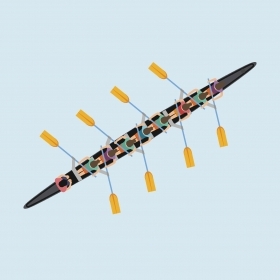Photo by Richard Howard
In the Swim
When Claire Whitaker ’19 was in sixth grade, she tried something new with her younger brother—the little-known sport of water polo. “The original intent was that my brother would learn how to swim, so that we could go on family vacations without him crying when there were pools,” she laughs. “But we both ended up really liking it.” Whitaker was eventually recruited to play water polo at Division I schools, but she chose another path. “I decided that I wanted to focus on academics, and I wasn’t going to join the Wellesley water polo team,” she says. But by the second semester of her first year, she realized she missed the sport and joined the team anyway. She was water polo’s co-president this year.
6 on 6
What does playing water polo entail? The rules vary a bit depending on where and by whom it’s being played, but Wellesley plays as a club team in the North Atlantic Division, governed by the Collegiate Water Polo Association. There are six field players on each team, plus one goalie, and everyone but the goalie plays on both offense and defense. “The goal is to swim the other team down the pool and score,” Whitaker says. Just one small catch: Field players can only touch the ball with one hand. Oh, and one other small catch: Players cannot touch the bottom or the sides of the pool. “Generally, you are playing in a 10-foot-deep pool,” Whitaker says. “There’s a lot of treading water.”
28:00
Players have to swim or tread water for the duration of the game, which is played in seven-minute quarters. Although 28 minutes of swimming seems difficult, that’s not really the true length of the game. “With fouls and the downtime after goals, because it’s not a running clock, the games end up lasting closer to 50 minutes to an hour,” Whitaker says. Luckily, substitutions are allowed to give players a rest.
Tough Sport
Whitaker’s endurance goes beyond just her ability to stay in the water, however. Over the course of her water polo career, she’s broken her hand three times and gotten a concussion. “It’s a somewhat violent sport,” she says. “But it’s definitely worth it.”
Pool School
Being part of a team is one of the reasons Whitaker keeps coming back to water polo. “Initially what drew me in was just wanting to be a part of something,” she says. Working with other players and her coaches is invaluable to her, especially at Wellesley. She played at a high level on a club team at the Naval Academy Aquatic Club in her hometown of Annapolis, Md., but Wellesley’s water polo team often includes players with no water polo experience at all. “At Wellesley, it’s different because we have a lot of new people. We have people who’ve been on swim teams … and we also have people who don’t know how to swim,” Whitaker says. “It’s really fun to mentor these new people and watch them grow as swimmers and water polo players.” Despite the wide range of skill levels, the team has been successful. After finishing second in its division with a regular-season record of 5-3 in 2016, the team entered the division championship game undefeated this year, with an 8-0 record. Unfortunately, they lost 8-7 to MIT in the final. “It was a really close game,” Whitaker says. “But we had a really good season. We have a lot of potential to be even better next year.”






We ask that those who engage in Wellesley magazine's online community act with honesty, integrity, and respect. (Remember the honor code, alums?) We reserve the right to remove comments by impersonators or comments that are not civil and relevant to the subject at hand. By posting here, you are permitting Wellesley magazine to edit and republish your comment in all media. Please remember that all posts are public.